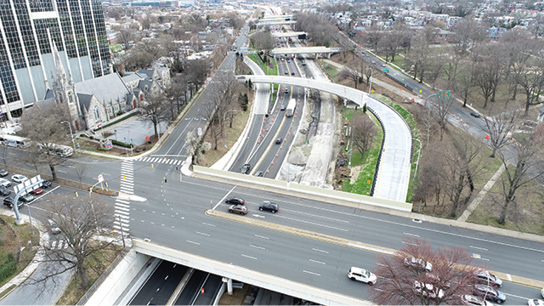
States Innovate!
Delaware Uses CM/GC to Restore the Corridor
The Delaware Department of Transportation (DelDOT) is using the construction manager/general contractor (CM/GC) project delivery method for its Interstate 95 Restore the Corridor project in Wilmington. The project includes repair of 19 bridges, pavement, and ramps on a critical corridor with an estimated annual average daily traffic of 110,000 vehicles per day. DelDOT’s project website states that the agency expects the CM/GC process to improve the project by lowering construction risk and offering engineering innovations to enhance the efficiency of construction and project quality.

Delaware is using the construction manager/general contractor method to deliver a major Interstate 95 corridor project that involves repair of 19 bridges, pavement, and ramps.
Credit: Delaware Department of TransportationStates Use Crowdsourced Data to Alert Commercial Vehicles
The New Jersey and Colorado DOTs are using crowdsourced data and private sector partnerships to deliver real-time information to commercial vehicles and improve the safety of all road users. Because commercial vehicles have far greater stopping distances, unexpected slowdowns on roadways pose a significant safety threat, particularly at the back of queues. Transportation agencies can now deliver in-cab alerts about road conditions through connected truck service providers to help commercial vehicle drivers approach and react more quickly to roadway incidents, work zones, and adverse weather conditions. Learn more from the Crowdsourced Data for Commercial Vehicles webinar, part of the Adventures in Crowdsourcing webinar series.
Georgia and North Carolina Use Texts to Boost Outreach
The Georgia Department of Transportation (GDOT) uses text messaging as a virtual public involvement (VPI) strategy for outreach to communities with low broadband access, where residents may face barriers to participating in other VPI formats such as online meetings. The text messages provide information about upcoming meetings or other opportunities to engage in transportation planning and project development. GDOT pairs text messaging and other VPI techniques with in-person outreach and physical mailings to try to reach all members of the community. The North Carolina Department of Transportation (NCDOT) has also had success using text messaging in its public involvement program. NCDOT often conducts online surveys to engage the community and uses text messaging as part of a multifaceted outreach approach that includes social and traditional media promotion, email, and in-person engagement. Texting surveys gives the public another option to get engaged using the method of their choosing.
Idaho Integrates Public Input on Pocatello Interchange
The Idaho Transportation Department’s (ITD) I-86/I-15 System Interchange project will replace aging and obsolete bridges built in the mid-1960s and address traffic congestion resulting from significant population growth in the area. Also, as a result of public feedback gathered in 2018 and 2021, ITD will build a new, separated pedestrian/bicycle pathway. “Bicycle and pedestrian access to the Highland area was something the community saw as very important,” Co-Project Manager Greg Roberts said in an ITD news release. ITD used virtual public involvement strategies to support public participation in the decision-making process, including an interactive GIS map of the project area with a comments portal and a digital visualization of the planned improvements.
The Idaho Transportation Department created a video animation to inform and engage public comment on its I-86/I-15 system interchange project.
Credit: Idaho Transportation DepartmentRhode Island STEPs Up Safety at Midblock Crossings
The Rhode Island Department of Transportation (RIDOT) developed an uncontrolled midblock crossing evaluation tool that is enabling it to address safety at more than 900 State-owned midblock crosswalks. RIDOT used an app to streamline data collection and developed a dashboard to automate crash countermeasure selection for each inventoried crosswalk. Treatments included countermeasures promoted by FHWA’s Safe Transportation for Every Pedestrian initiative such as rectangular rapid flashing beacons and pedestrian hybrid beacons. RIDOT applied State Transportation Innovation Council funds toward developing the app and an FHWA Accelerated Innovation Deployment (AID) Demonstration program grant toward installing some of these enhancements. Read about RIDOT’s effort in FHWA’s Safety Compass newsletter.
Oklahoma DOT’s Project Bundling Creates Bidding Options
In 2021, the Oklahoma Department of Transportation (ODOT) used a unique approach to project bundling when it advertised six sets of optionally bundled projects, saving an estimated $1.4 million. This bundling method provided contractors with options to address factors that may hinder some from bidding on typically bundled projects. According to ODOT, contractors most often prefer larger bundles of projects, but there are factors that may make smaller bundles, or even separate contracts more attractive at times. For example, bonding capacity may limit the contractor’s ability to bid a large bundle of projects. Also, bidding smaller separate contracts can give the contractor more flexibility over the construction schedule. Optional ties provide contractors flexibility to bid on individual contracts or in bundles because one size doesn’t fit all situations. This approach also makes it easier for an agency to demonstrate the cost savings of project bundling by comparing the bids for separate projects to bids for combined projects, rather than comparing bids to engineer estimates.
Notice: The U.S. Government does not endorse products or manufacturers. Trademarks or manufacturers’ names appear in this article only because they are considered essential to the objective of the document.
Recommended Citation: U.S. Department of Transportation, Federal Highway Administration - Washington, DC (2022) Innovator Newsletter, July/August 2022, Volume 16 (91). https://doi.org/10.21949/1521845



